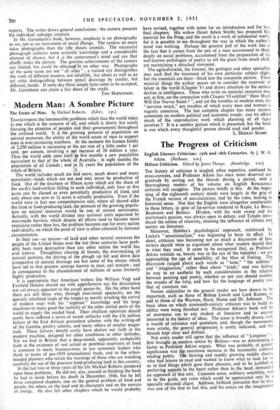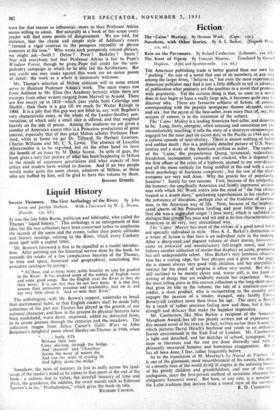The Progress of Criticism
Milton Criticism. Edited by James Thorpe. (Routledge. 2 is.) THE history of criticism is tangled, often repetitive, confused by cross-currents, and Professor Atkins has .once more deserved our gratitude by sorting out the threads during a period, with a thoroughness readers of his volume on English Renascence criticism will recgase. The picture briefly is this. At the begin- ning of the eighteenth century minds were largely in the grip of the French version, of neo-classicism, tied by the rules, lacking in historical sense. Not that the English were altogether comfortable in these fetters, in spite of lip-service rendered to Rapin, Le Bossu, Bouhours and Boileau. Dryden, with his wide sweep and his craftsman's passion, was always open to debate, and Temple intro- duced the notion of relativity, stressing the influence of climate and society on literature.
Moreover, Hobbes's psychological approach, reinforced by Locke's " sensationalism," was beginning to have its effect. In short, criticism was becoming not so much a discussion of how writers should Write as argument about what readers should find in what they read. It came to be recognised that, as Professor Atkins reminds us, beauty was in the eye of the beholder ; we are approaching the age of sensibility, of the Man of Feeling. The discussion ranged about such words as " taste," " the sublime " and " imagination," rather than about " kinds," and was feeling its way to an aesthetic by such considerations as the relation between painting and poetry, whether or not you should number the streaks of the Tulip, and how far the language of poetry was that of common use.
Names unfamiliar to the general reader are here shown to be important, such as those of Bishop Lowth-and Lord Karnes, to add to those of the Wartons, Hurd, Hume and Dr. Johnson. The basic ideas on which nineteenth-century criticism was to build its edifice were being threshed out. Professor Atkins's book will be of enormous use to any student of . literature and to anyone interested in the history of ideas. The scene is broadly drawn, with a wealth of reference and quotation, and, though the movements were erratic, the .general progression is surely indicated, and the threads kept clear and distinct. Not every reader will agree that the influence of " Longinus "- first brought to,modern notice by ffoileau—was so determining a factor as ProfeSsor Atkins argues. What was probably of greater significance was the enormous increase in the reasonably cultured reading public. The thriving and rapidly growing middle classes, who had leisure to read and wanted to know what to look for so as to find things which gave them pleasure, and to be justified in preferring appeals to the heart rather than to the bead, demanded an approach of'this sort. Common sense, ordinary sensibility, was to be the guide, not rules-which could be appreciated only by a • specially educated clique. Addison, brilliant journalist that he was, was one-of the first to feel this, and his essays-on the imagination
were for that reason so influential—more so than Professor Atkins seems willing to admit. But naturally in a' book of this scope every reader will find some points of disagreement. We are told, for instance, that the chaste and simple style of Addison's essays " formed a vivid contrast -to the pompous rotundity of phrase common at the time." Who wrote such pompously rotund phrases, we might ask—Swift-? Defoe ? Prior ? Berkeley ? Steele ? Nor will everybody feel that Professor Atkins is fair to Pope's Windsor Forest, though he gives -Pope full credit for the anti- pedantry campaign in which he so ably led the Scriblerians. But any cavils one may make against this work are on minor points of detail: the work as a whole is immensely welcome.
Mr. Thorpe's selection of Milton criticism will to some extent serve to illustrate Professor Atkins's work. The main essays run from Addison to Mr. Eliot (his Academy lecture), while there are excerpts from other writers ranging from Marvell to Arnold. There are five essay's up to 1818—Which year yields both Coleridge and Hazlitt ; then, there is a gap till we reach Sir Walter Raleigh in 1900. It is a pity that this gap was not filled in, say, with Bagebot's very characteristic essay, or the whole of the Landor-Southey con- versation, of which only a small slice is offered, and that weighted heavily on the side of praise.. Among -the moderns we are given a number of American essays (this is a Princeton production) of great interest, especially that of that grkat Milton scholar Professor Han- ford, while at home we get Dr. Tillyard, 'Sir Herbert Grierson, Charles Williams and Mr. CC. S., Lewis. The absence of Lascelles Abercrombie is to be regretted, but on the other hand we have the benefit of an essay by M. Denis Saurat. In spite of gaps, the book gives a very fair picture of wfiatbas been-happening to Milton in the minds of successive generatiOns and what aspects of him critics and readers have wished to discuss. And if no two people would make quite the same choice, admirers of Milton, or those who are baffled by him, will be glad to have this volume by them.
BGNAMY DOBREE.



































 Previous page
Previous page